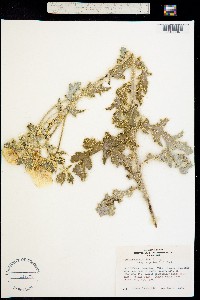Argemone munita
|
|
|
|
Family: Papaveraceae
Flat-Bud Prickly-Poppy, more...flatbud pricklypoppy, flat-bud prickly poppy
|
Plants annual or perennial. Stems 4-16 dm, densely to sparingly prickly. Leaf blades: surfaces copiously prickly on veins and intervein surfaces to sparingly prickly on main veins only; basal lobed ca. 1/2 distance to midrib, lobe apices usually distinctly rounded, marginal teeth usually less than 1 mm; distal usually definitely clasping. Inflorescences: buds oblong to ellipsoid to obovoid, body 12-22 × 10-16 mm, prickly; sepal horns terete, flattened or angular in cross section, (4-)6-8(-10) mm, unarmed to densely prickly. Flowers 5-10(-13) cm broad, not closely subtended by foliaceous bracts; petals white; stamens 150-250; filaments pale yellow; pistil 3-5-carpellate. Capsules ovoid, ellipsoid, or lanceoloid, 35-55 × 9-15(-18) mm (including stigma and excluding prickles), prickly, longest prickles to 10 mm, widely spaced, or shorter, more numerous, and interspersed with still shorter prickles, surface then partially obscured. Seeds 1.8-2.6 mm. The Kawaiisu used Argemone munita medicinally to treat burns (D. E. Moerman 1986, no varieties specified).
Plant: shrub or herb; STEMS densely to sparingly prickly Leaves: copiously prickly on the veins and intervein surfaces to sparingly prickly only on the main veins; basal and lower cauline leaves lobed about one-fourth to three-fourths to the midrib, the lobes usually distinctly rounded; uppermost leaves half-clasping INFLORESCENCE: cymose Flowers: buds oblong to elliptic or obovate; sepals variably prickly, the horn terete, angular or flattened in cross-section, the base of the apical prickle usually flattened and indurated; petals white; stamens 150 or more Fruit: capsules elliptic, ovate or lanceolate; capsular prickles widely spaced and few to numerous, the largest prickles 6-10 mm long; SEEDS numerous, pitted Misc: Mar-May REFERENCES: Ownbey, Gerald B., Jeffrey W. Brasher, and Curtis Clark. 1998 Papaveraceae. J. Ariz. - Nev. Acad. Sci. 30(2): 120. General: Annual or perennial, 40-100 cm tall; stems erect, purplish, usually densely prickly, the longest prickles 4-6 mm long. Leaves: Basal (forming a rosette) and cauline, alternate, oblanceolate to lyrate in outline, the basal and lower cauline blades lobed to about half the distance to the midrib, the lobes distinctly rounded, the upper blades clasping the stem, surfaces glaucous, densely prickly throughout, margins with very short teeth, these bearing prickles; blades sessile. Flowers: Inflorescence usually 1-flowered; pedicel 1-3 cm long, horizontal to erect in fruit; calyx 4-5 mm long, pubescent; corolla 3.5-11 mm long, yellow to yellow- orange; flowers April-July. Fruits: Capsule, ovoid to ellipsoid, 35-55 mm long, usually densely prickly, the longest prickles up to 8 mm long; seeds numerous. Ecology: Deserts, slopes, foothills; 1200-2600 m (4000-8500 ft); Coconino, Maricopa, and Mohave counties; southwestern U.S. Notes: Ours, as here described, is ssp. rotundata. Argemone pleiacantha (southwestern pricklypoppy) is distinguished by blades of the lower leaves lobed for 3/4 the distance to the midrib, the tips of the lobes angular, surfaces seldom prickly except on the veins, the teeth along the margins prominent; flower buds are oblong. It occurs only marginally within our elevational range, found in foothills, plains, gravelly soils. Editor: Springer et al. 2008 |








































































